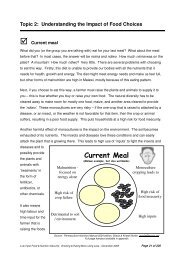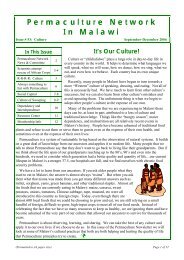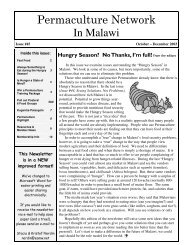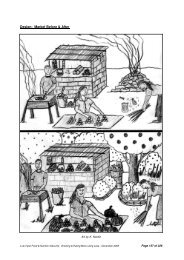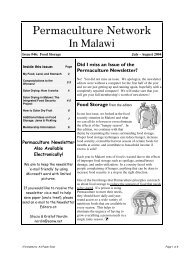Permaculture, Final Capstone Paper 5-26, Hope - Never Ending Food
Permaculture, Final Capstone Paper 5-26, Hope - Never Ending Food
Permaculture, Final Capstone Paper 5-26, Hope - Never Ending Food
Create successful ePaper yourself
Turn your PDF publications into a flip-book with our unique Google optimized e-Paper software.
A. SNAPSHOT MALAWI<br />
Lying south of the equator, Malawi is a landlocked country sharing borders with<br />
Tanzania, Mozambique and Zambia. It is 900 kilometers long and ranges in width from 80 to<br />
161 kilometers (UNDP, 2007) . Lake Malawi is the world’s ninth largest lake making up nearly<br />
one fifth of the nations land area and, along with altitude, the lake heavily influences Malawi’s<br />
warm tropical climate.<br />
The country is divided into 27 districts within the Northern, Central and Southern<br />
Regions. The districts are subdivided into Traditional Authorities (TA’s), which are governed by<br />
chiefs. Traditional Authorities are comprised of villages, the smallest administrative unit, and<br />
are governed by village headmen. Before gaining independence in 1964, Malawi was under<br />
British Colonial rule from 1891. In 1994, Malawi became a multi-party democracy adopting a<br />
poverty reduction strategy including a neo-liberal market economy as well as mandating free and<br />
compulsory primary school education.<br />
Agriculture is the most critical sector of the Malawian economy as it consists of nearly 40<br />
percent of the GDP, employs 85 percent of work force and provides an estimated 64% of the<br />
total income of rural Malawians (UNDP, 2007). In 2005, over 90 percent of Malawi’s foreign<br />
exchange earnings were a result of tobacco, tea, and sugar production. (FAO, 2005; MoA, 2005)<br />
In addition to being the foundation of the economy, between 85-90% are subsistence farmers and<br />
rely on agriculture for their daily food intake (MoA, 2005). Between 70% and 80% of arable<br />
land in Malawi is under maize production (Sauer, Tchale & Wobst, 2006; Peters 1999), with<br />
maize constituting 90% of cereal production and, in turn, making Malawians, the highest per<br />
capita consumers of maize in the world at148 kgs. per capita per annum (Sauer, Tchale & Wobst,<br />
2006).<br />
5



